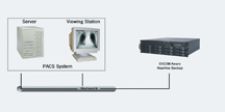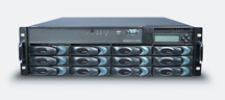
Figure 1: A rack-mountable storage grid for medical imaging.
Digital imaging is now ubiquitous in medicine. Contemporary imaging modalities are generating an ever-increasing amount of data, and a growing number of healthcare professionals require access to this data. However, this exponential increase in the generation and usage of digital imaging poses new data management problems for the administrators of picture archiving and communication systems (PACS). In response, emerging storage grid technologies offer a practical means to addressing many of these problems.
Explosion of Imaging Data
Over the past decade, there has been a rapid increase in the volume of data produced by cross-sectional imaging modalities such as X-ray computed tomography (CT), magnetic resonance angiography (MRA) and single-photon and positron emission tomography (SPECT and PET). New cross-sectional imaging techniques, such as MRA, spectroscopy and diffusion, and new imaging approaches, such as combined PET/CT imaging, are generating even greater volumes of data per procedure. Other digital modalities, such as ultrasound (US) and digital rotational angiography (3DRA), are evolving toward higher-resolution, volumetric imaging – which also generates increasingly larger data sets.
At the same time, traditionally film-based, projection X-ray imaging has shifted toward the use of newer digital imaging technologies such as computed radiography (CR) and digital radiology (DR). While a typical CR image might be, on average, only 20 MB in size, each CR unit could potentially produce as many as 60 images per hour. DR can produce even larger data sets. With the advent of new capabilities and new imaging applications, the amount of data generated by each medical imaging modality is likely to increase even further.
PACS Infrastructure Lags Behind Medical Imaging Modalities
If PACS administrators were able to easily reconfigure and upgrade their PACS solutions, then this explosion in data volume might not be a significant concern. However, while hospitals and imaging centers routinely upgrade their medical imaging modalities every two to three years (or even annually), most PACS financial models only allow for upgrading PACS technology every five or more years. As a result, most facilities are adding new capabilities and generating more data at each imaging modality, only to find their information technology inadequate for managing that data.
In addition, PACS administrators, particularly at an imaging center, are increasingly using Web-based image distribution to address the increased utilization of imaging by their referring physicians and other healthcare professionals. This involves routing and transmitting more data, which further taxes the already-strained existing image storage and distribution components of the PACS.
Upgrading the PACS infrastructure to accommodate increased data storage and transmission needs is often difficult or impossible because of the cost-prohibitive nature of PACS upgrades and the complexity of making changes to the PACS infrastructure.
Efficient Data Storage and Management
In today’s rapidly changing imaging environment, PACS administrators need more efficient technology for managing images and related information. In such an environment, administrators need to be able to easily increase storage capacity and distribute data to new destinations without having to upgrade their PACS infrastructure (see Table 1).
A storage grid combines one or more high-performance, network-attached storage servers with intelligent software for data receipt, data storage on multiple servers on the grid and data routing over the network. The software often includes an easy-to-use graphical user interface (GUI) for programming the “business rules” that determine how to manage the data. For example, one rule might specify how to create backup copies of the data on independent storage servers across the grid, while another might route copies of the data to local or remote destinations.
Some vendors have optimized storage grid technology for medical imaging. For example, Candelis Inc., has created a DICOM server appliance (ImageGrid) that integrates industry-standard RAID and a programmable disk controller with an appliance operating system, an embedded database and a suite of DICOM services into a neatly packaged, rack-mountable box, as shown in Figure 1.
The advantage of a storage grid configured as a DICOM server appliance is that it provides many of the capabilities found in larger, more expensive PACS, but is significantly easier to install, configure and administer than a PACS. For example, it can be added into an existing PACS to increase storage capacity, as illustrated in Figure 2. Alternatively, it can be used to provide long-term storage and to add new routing capabilities to a digital imaging modality in either a PACS or a nonPACS environment, as illustrated in Figure 3.
A DICOM storage grid also provides all of the performance and reliability of a storage grid with the data encryption and security required under the Health Insurance Portability and Accountability Act (HIPAA). In the configuration illustrated in Figure 3, the storage grid is programmed to transmit data from specific modalities to specific locations, authenticates users and logs the transmission of medical records – all while successfully encrypting the data prior to transmission over the wide area network (WAN).
There are a number of other advantages of DICOM storage grids. Imaging data can be archived to another DICOM server appliance at the site or, for better protection against loss and disaster recovery, to another DICOM server appliance at a remote site. An easy-to-use, Web-based GUI is typically provided to enable the PACS administrator to define rules for storing the images, creating backups and routing images between locations.
In addition, imaging studies can be routed automatically (without the intervention of imaging center staff) to the referring physician who ordered the study. If a PACS is later installed or upgraded, the PACS administrator can define rules to quickly retrieve and transfer images using a DICOM format for the PACS archive. Lastly, because DICOM storage grids use off-the-shelf disk drives that can easily be added to an existing chassis, and because multiple chassis can easily be managed, adding storage capacity becomes effortless and inexpensive. This is particularly important for imaging centers, clinics or even small hospitals that lack the budget for PACS infrastructure upgrades.
Storage grid technology provides a reliable, secure and extremely cost-effective means of storing medical images and related data. DICOM storage grids represent the next step in the evolution of this technology, providing an easy-to-manage, low-cost and practical solution to the challenges associated with upgrading the storage capacity or adding DICOM services to an existing PACS in our increasingly digital age.





 December 01, 2025
December 01, 2025 









